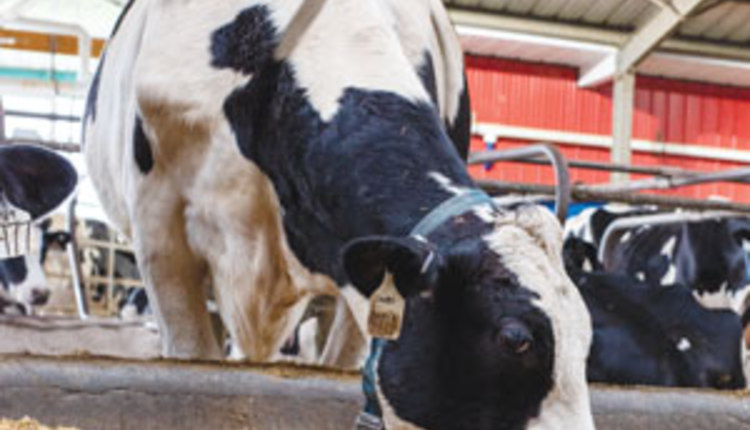DeVries is a professor at the University of Guelph; Havekes and Moore worked with DeVries as graduate students. Havekes now serves as a Cornell dairy management specialist.
From a behavioral standpoint, one of the major drawbacks of these diets is that cows tend to sort away from the straw and, subsequently, consume an unbalanced diet, particularly when the straw particle size is too long. From a nutritional standpoint, incorporating large amounts of straw could lengthen rumen retention time and limit intake — a consequence we would like to avoid given the positive effects of maximizing intake in the weeks leading up to calving. Because sugar supplementation aids fiber digesting bacteria, it may be more favorable to do so when cows are fed a high-forage, lesser fermentable diet.
To investigate these ideas, our research group at the University of Guelph conducted a study to determine if dry cows fed a high-straw diet would benefit from molasses-based liquid feed supplementation. Holstein cows were enrolled at dry off and randomly assigned to one of two dietary treatments: a high-straw dry cow diet (with straw chopped in a tub grinder with a 1-inch [2.54-cm] screen) with either:
As hypothesized, the cows fed molasses had greater feed intake compared to the control group. The greatest difference in intake was recorded in the week leading up to calving, where cows fed molasses were able to maintain more consistent intake. This is an important finding, as in previous research it has been demonstrated that greater drops in intake as cows approach calving are associated with greater risk of experiencing metabolic disease postcalving.
The dry cows fed the molasses also tended to have more frequent meals and a shorter time interval between meals, while not consuming any more feed within a meal, suggesting that the molasses positively impacted feed digestibility. This finding supports the idea that molasses may have an increasingly important role in diets where digestibility is compromised due to high inclusion rates of lesser quality forages.
Cows fed the molasses during the dry period also had, on average, lower maximum blood beta-hydroxybutyrate (BHB) levels postcalving. This metabolic effect is likely attributable to the differences between our treatment groups in consistency in intake, both in amount and composition, particularly in the week leading up to calving.
In previous research from our university, it was demonstrated that the herd-level prevalence of subclinical ketosis in Ontario, Canada, was greater in AMS herds compared to conventionally milked herds. Greater milking frequency and yield in early lactation for AMS cows may be contributing factors to that finding. In another study we observed that development of subclinical ketosis in commercial AMS-milked cows was associated with greater production of milk relative to the amount of feed provided in the AMS during the first week postcalving. This suggests that inadequate supplementation at that time was contributing to that subclinical ketosis risk. Therefore, we hypothesized that more energy supplementation in early lactation at the AMS unit via sugar from molasses (as opposed to greater starch) would prove beneficial for AMS cows.
Cows receiving molasses at the AMS had fewer repeat positive subclinical ketosis tests (blood BHB ≥ 1.2 mmol/L) and lower average blood BHB levels at about 15 DIM. Those cows receiving the molasses also maintained a more stable body condition score, as they tended to lose less body condition across the first 60 DIM compared to the control cows. Thus, the results of this work confirmed that we can bridge the energy gap in fresh cows milked in AMS through molasses-based liquid feed supplementation.

Molasses benefits cows when fed in both dry cow and early lactation diets.
The benefits of feeding sugar, often by means of molasses, to dairy cows have been well-researched. From a physiological standpoint, sugar supplementation improves microbial efficiency and supports fiber-digesting bacteria, ultimately promoting the opportunity for greater feed intake. Sugar supplementation also enhances butyrate production in the rumen and elevates mean ruminal pH.
From a feeding behavior standpoint, sugar supplementation in the form of liquid molasses within a total mixed ration (TMR) can help adhere smaller particles to larger particles, thus making those diets physically more difficult to sort. Additionally, dairy cattle prefer sweet tasting flavors, and thus, are more likely to consume greater amounts of diets with added sugar.What about dry cow diets?
Much of the research on molasses supplementation has been done with lactating cow diets. Given the ample benefits related to enhanced intakes, reduced sorting, and improved rumen health, could similar results be observed with dry cow diets, particularly those controlled energy ones that are high in straw content? These dry cow diets incorporate large amounts of low nutrient dense feedstuffs (typically wheat straw), in an attempt to reduce the energy density so that the cow can consume as much as she physically wants to, without running the risk of gaining excessive body condition.From a behavioral standpoint, one of the major drawbacks of these diets is that cows tend to sort away from the straw and, subsequently, consume an unbalanced diet, particularly when the straw particle size is too long. From a nutritional standpoint, incorporating large amounts of straw could lengthen rumen retention time and limit intake — a consequence we would like to avoid given the positive effects of maximizing intake in the weeks leading up to calving. Because sugar supplementation aids fiber digesting bacteria, it may be more favorable to do so when cows are fed a high-forage, lesser fermentable diet.
To investigate these ideas, our research group at the University of Guelph conducted a study to determine if dry cows fed a high-straw diet would benefit from molasses-based liquid feed supplementation. Holstein cows were enrolled at dry off and randomly assigned to one of two dietary treatments: a high-straw dry cow diet (with straw chopped in a tub grinder with a 1-inch [2.54-cm] screen) with either:
- No molasses supplementation
- Molasses supplemented at 1 kilogram or 2.2 pounds per cow per day (dry matter basis)
As hypothesized, the cows fed molasses had greater feed intake compared to the control group. The greatest difference in intake was recorded in the week leading up to calving, where cows fed molasses were able to maintain more consistent intake. This is an important finding, as in previous research it has been demonstrated that greater drops in intake as cows approach calving are associated with greater risk of experiencing metabolic disease postcalving.
The dry cows fed the molasses also tended to have more frequent meals and a shorter time interval between meals, while not consuming any more feed within a meal, suggesting that the molasses positively impacted feed digestibility. This finding supports the idea that molasses may have an increasingly important role in diets where digestibility is compromised due to high inclusion rates of lesser quality forages.
Cows fed the molasses during the dry period also had, on average, lower maximum blood beta-hydroxybutyrate (BHB) levels postcalving. This metabolic effect is likely attributable to the differences between our treatment groups in consistency in intake, both in amount and composition, particularly in the week leading up to calving.
What about robots?
Given the positive effects we observed in supplementing dry cows with molasses, we also hypothesized that the supplementation of molasses to fresh cows would have positive impacts on energy balance in the early postpartum period. Specifically, our group was interested in testing this on fresh cows milked in automated (robotic) milking systems (AMS).In previous research from our university, it was demonstrated that the herd-level prevalence of subclinical ketosis in Ontario, Canada, was greater in AMS herds compared to conventionally milked herds. Greater milking frequency and yield in early lactation for AMS cows may be contributing factors to that finding. In another study we observed that development of subclinical ketosis in commercial AMS-milked cows was associated with greater production of milk relative to the amount of feed provided in the AMS during the first week postcalving. This suggests that inadequate supplementation at that time was contributing to that subclinical ketosis risk. Therefore, we hypothesized that more energy supplementation in early lactation at the AMS unit via sugar from molasses (as opposed to greater starch) would prove beneficial for AMS cows.
Two feeds testing
Cows receiving molasses at the AMS had fewer repeat positive subclinical ketosis tests (blood BHB ≥ 1.2 mmol/L) and lower average blood BHB levels at about 15 DIM. Those cows receiving the molasses also maintained a more stable body condition score, as they tended to lose less body condition across the first 60 DIM compared to the control cows. Thus, the results of this work confirmed that we can bridge the energy gap in fresh cows milked in AMS through molasses-based liquid feed supplementation.
Both pre- and postcalving
Overall, our research has demonstrated that pre- and postpartum provision of supplemental sugar to dairy cows, in particular through a molasses-based liquid feed, may be beneficial for postpartum metabolic and rumen health. This should then set cows up for a more successful lactation given that those immediate benefits in the vulnerable early lactation period are known to have lasting effects on productive and reproductive success.









